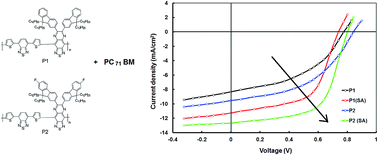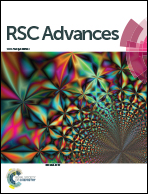Synthesis of new D-A1–D-A2 type low bandgap terpolymers based on different thiadiazoloquinoxaline acceptor units for efficient polymer solar cells†
Abstract
Two low bandgap D-A1–D-A2 conjugated copolymers, namely denoted as P1 (non-fluorine substituted thiadiazoloquinoxaline A2) and P2 (fluorine substituted thiadiazoloquinoxaline A2) with the same D (thiophene) and A1 (benzothiadiazole) groups were synthesized in order to investigate the effect of fluorine atoms on the photovoltaic performance of polymer solar cells. The electrochemical properties demonstrate that the highest occupied molecular orbital (HOMO) energy level lowered from −5.08 eV (for P1) to −5.16 eV (for P2), whereas the lowest unoccupied molecular orbital (LUMO) energy levels remain nearly the same. These copolymers showed strong absorption in the wavelength range 300–1100 nm and have a bandgap of around 1.08 and 1.11 eV for P1 and P2, respectively. After the optimization of the weight ratio and concentration of solvent additives 1-chloronaphathalene (CN), the highest power conversion efficiencies of bulk heterojunction polymer solar cells achieved were up to 5.30% and 7.21% for P1 and P2 as donor and PC71BM as acceptor. The enhanced Voc and Jsc for the P2 based device can be mainly ascribed to the lower HOMO energy levels and higher hole mobility and better morphology of the fluorinated copolymer P2 : PC71BM blend.


 Please wait while we load your content...
Please wait while we load your content...